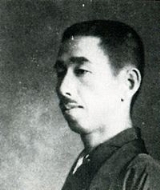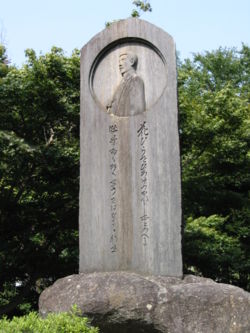
Kinoshita Rigen
Encyclopedia
Viscount
was the pen-name of Japanese author Kinoshita Toshiharu, noted for his tanka poetry, active in Meiji period
and Taishō period
Japan
.
city, Okayama prefecture
, and is a direct lineal descendent of a brother-in-law of Toyotomi Hideyoshi
. His uncle, Kinoshita Toshiyasu, was the 13th and last daimyo
of Ashimori han (25,000 koku
). After the Meiji Restoration
, he was given the title of viscount
(shishaku) under the kazoku
peerage system. When he died, his nephew Kinoshita Rigen, only 5 years old, succeeded to the main family as Viscount Kinoshita. Kinoshita would have thus been a daimyo
if the Tokugawa shogunate
had lasted only a few years longer. In any event, Kinoshita graduated from the Literature Department of Tokyo Imperial University
. His classmates included Shiga Naoya and Mushanokōji Saneatsu, and he was a student of the noted poet Sasaki Nobutsuna
.
, with elegant tanka
verses, written in an easy-to-understand colloquial language. He published numerous anthologies of his verses, including Kogyoku ("Red Ball", 1919) and Ichiro ("One Alley", 1924).
Kinoshita moved to Kamakura
, Kanagawa prefecture
in 1919, as the sea air had a reputation for being good for lung disorders. However, he was diagnosed with tuberculosis
and died a few years later.

Viscount
A viscount or viscountess is a member of the European nobility whose comital title ranks usually, as in the British peerage, above a baron, below an earl or a count .-Etymology:...
was the pen-name of Japanese author Kinoshita Toshiharu, noted for his tanka poetry, active in Meiji period
Meiji period
The , also known as the Meiji era, is a Japanese era which extended from September 1868 through July 1912. This period represents the first half of the Empire of Japan.- Meiji Restoration and the emperor :...
and Taishō period
Taisho period
The , or Taishō era, is a period in the history of Japan dating from July 30, 1912 to December 25, 1926, coinciding with the reign of the Taishō Emperor. The health of the new emperor was weak, which prompted the shift in political power from the old oligarchic group of elder statesmen to the Diet...
Japan
Japan
Japan is an island nation in East Asia. Located in the Pacific Ocean, it lies to the east of the Sea of Japan, China, North Korea, South Korea and Russia, stretching from the Sea of Okhotsk in the north to the East China Sea and Taiwan in the south...
.
Early life
Kinoshita was born in what is now part of OkayanaOkayama, Okayama
is the capital city of Okayama Prefecture in the Chūgoku region of Japan.The city was founded on June 1, 1889. As of August 2010, the city has an estimated population of 705,224 and a population density of 893 persons per km². The total area is 789.88 km²....
city, Okayama prefecture
Okayama Prefecture
is a prefecture of Japan located in the Chūgoku region on Honshū island. The capital is the city of Okayama.- History :During the Meiji Restoration, the area of Okayama Prefecture was known as Bitchū Province, Bizen Province and Mimasaka Province.- Geography :...
, and is a direct lineal descendent of a brother-in-law of Toyotomi Hideyoshi
Toyotomi Hideyoshi
was a daimyo warrior, general and politician of the Sengoku period. He unified the political factions of Japan. He succeeded his former liege lord, Oda Nobunaga, and brought an end to the Sengoku period. The period of his rule is often called the Momoyama period, named after Hideyoshi's castle...
. His uncle, Kinoshita Toshiyasu, was the 13th and last daimyo
Daimyo
is a generic term referring to the powerful territorial lords in pre-modern Japan who ruled most of the country from their vast, hereditary land holdings...
of Ashimori han (25,000 koku
Koku
The is a Japanese unit of volume, equal to ten cubic shaku. In this definition, 3.5937 koku equal one cubic metre, i.e. 1 koku is approximately 278.3 litres. The koku was originally defined as a quantity of rice, historically defined as enough rice to feed one person for one year...
). After the Meiji Restoration
Meiji Restoration
The , also known as the Meiji Ishin, Revolution, Reform or Renewal, was a chain of events that restored imperial rule to Japan in 1868...
, he was given the title of viscount
Viscount
A viscount or viscountess is a member of the European nobility whose comital title ranks usually, as in the British peerage, above a baron, below an earl or a count .-Etymology:...
(shishaku) under the kazoku
Kazoku
The was the hereditary peerage of the Empire of Japan that existed between 1869 and 1947.-Origins:Following the Meiji Restoration of 1868, the ancient court nobility of Kyoto regained some of its lost status...
peerage system. When he died, his nephew Kinoshita Rigen, only 5 years old, succeeded to the main family as Viscount Kinoshita. Kinoshita would have thus been a daimyo
Daimyo
is a generic term referring to the powerful territorial lords in pre-modern Japan who ruled most of the country from their vast, hereditary land holdings...
if the Tokugawa shogunate
Tokugawa shogunate
The Tokugawa shogunate, also known as the and the , was a feudal regime of Japan established by Tokugawa Ieyasu and ruled by the shoguns of the Tokugawa family. This period is known as the Edo period and gets its name from the capital city, Edo, which is now called Tokyo, after the name was...
had lasted only a few years longer. In any event, Kinoshita graduated from the Literature Department of Tokyo Imperial University
University of Tokyo
, abbreviated as , is a major research university located in Tokyo, Japan. The University has 10 faculties with a total of around 30,000 students, 2,100 of whom are foreign. Its five campuses are in Hongō, Komaba, Kashiwa, Shirokane and Nakano. It is considered to be the most prestigious university...
. His classmates included Shiga Naoya and Mushanokōji Saneatsu, and he was a student of the noted poet Sasaki Nobutsuna
Sasaki Nobutsuna
was a tanka poet and scholar of the Nara and Heian periods of Japanese literature. He was active during the Shōwa period of Japan.-Early life:...
.
Literary career
Kinoshita was a co-founder of the Shirakaba ("White Birch") Society, along with Shiga Naoya and Mushanokōji Saneatsu in 1910. He contributed extensively to the society's literary magazineLiterary magazine
A literary magazine is a periodical devoted to literature in a broad sense. Literary magazines usually publish short stories, poetry and essays along with literary criticism, book reviews, biographical profiles of authors, interviews and letters...
, with elegant tanka
Waka (poetry)
Waka or Yamato uta is a genre of classical Japanese verse and one of the major genres of Japanese literature...
verses, written in an easy-to-understand colloquial language. He published numerous anthologies of his verses, including Kogyoku ("Red Ball", 1919) and Ichiro ("One Alley", 1924).
Kinoshita moved to Kamakura
Kamakura, Kanagawa
is a city located in Kanagawa Prefecture, Japan, about south-south-west of Tokyo. It used to be also called .Although Kamakura proper is today rather small, it is often described in history books as a former de facto capital of Japan as the seat of the Shogunate and of the Regency during the...
, Kanagawa prefecture
Kanagawa Prefecture
is a prefecture located in the southern Kantō region of Japan. The capital is Yokohama. Kanagawa is part of the Greater Tokyo Area.-History:The prefecture has some archaeological sites going back to the Jōmon period...
in 1919, as the sea air had a reputation for being good for lung disorders. However, he was diagnosed with tuberculosis
Tuberculosis
Tuberculosis, MTB, or TB is a common, and in many cases lethal, infectious disease caused by various strains of mycobacteria, usually Mycobacterium tuberculosis. Tuberculosis usually attacks the lungs but can also affect other parts of the body...
and died a few years later.

External links
- e-texts of works at Aozora BunkoAozora BunkoAozora Bunko is a Japanese digital library. This online collection encompasses several thousands of works of Japanese-language fiction and non-fiction. These include out-of-copyright books or works that the authors wish to make freely available....

